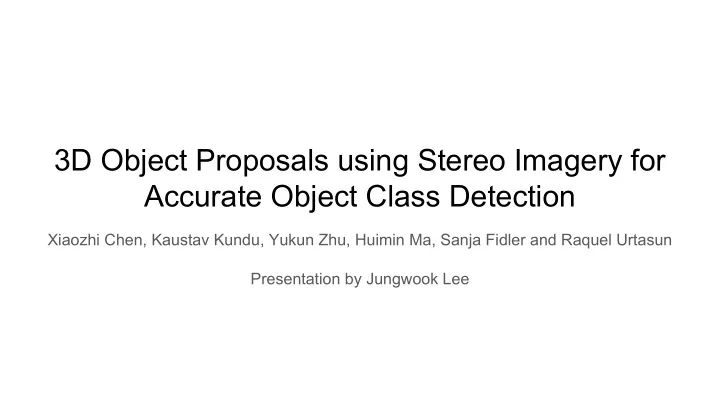

3D Object Proposals using Stereo Imagery for Accurate Object Class Detection Xiaozhi Chen, Kaustav Kundu, Yukun Zhu, Huimin Ma, Sanja Fidler and Raquel Urtasun Presentation by Jungwook Lee
Why use proposals? - Smart proposal generation methods helps in reduce the search space - High recall contributes to higher accuracy for overall detection - Current deep neural networks have very high performance on classification - 3D vs. 2D Proposals (occlusion, scale variation)
3D Object Proposal Generation - Proposal Generation as Energy Minimization
Point Cloud Density - Measure of how dense is a bounding box with point clouds
Free Space - Potential term to encourage less free space within the box
Height Prior - Potential which uses known average class height
Height Contrast - Potential that uses the fact surrounding box should have lower values of height relative to the “class box”
Inferencing Steps: 1) Compute , Discretize 3D space, Ground plane estimation 2) Candidate box sampling (along ground plane, skip empty boxes) 3) Exhaustive scoring based on 4) NMS to obtain top K diverse 3D proposals
Greedy Selection Algorithm
3D Object Detection Input : top-ranked 3D object proposals, stereo image (RGB, HHA) Output: Bounding Box Regression Parameters, Class Score, Orientation - Deep Neural Networks: Convolutional Networks (cs231n) - Based on R-CNN variant, Fast R-CNN
2D Detection Architecture
3D Detection Architecture
Performance Measures - Proposal Recall: Measure of how much of the objects that the proposals extract from the ground truth set. - Precision: Measure of how many of the actual positive detection are indeed true objects.
Performance Measures - Average Precision (2D, 3D), Average Localization Precision
Performance Measures - Average Orientation Similarity
Proposal Recall Results (2D)
Proposal Recall Results (3D) - 0.25 IoU, moderate data - Proposal Generation Runtime: ~ 2s for 2K proposals
Summary of Key Results - Hybrid approach using Lidar: - stereo PC for road region classification - lidar point for plane fitting and inferencing - Proposal Recall: - Hybrid good for small objects (pedestrian, cyclist) and far objects. - Highest 3D Recall with Hybrid, but 2D Recall is better with stereo. - Detection and Localization: - Stereo works best on 2D detection and Easy set for 3D detection. - Hybrid is best combination for 3D tasks on Moderate and Hard sets (Highest AP, ALP).
- Network design - Joint BB and OR (multi-task loss) results in boost in AOS, not much for AP(2D) - Contextual branch - Highest 2D AP and AOS for car. (by small margin) - Claims for pedestrian and cyclist, didn’t work out due to the number of weights (2x model for contextual branch and limited data for pedestrian and cyclist) - RGB-HHA stream - RGB-HHA requires more GPU memory, so used 7-layer VGG ConvNet weights - Improvement for both 2D (~0.5%) and 3D detection (~ 5-10%) than just RGB - 3D detection highest at 7 layer RGB-HHA with hybrid, (better than 16 layer RGB input) - Ground Plane - Using ground truth planes didn’t improve much for stereo - Only improves pure lidar approaches. (Good ground plane estimation needed for pure lidar based detection)
Contributions - Spatial information is far more important than appearance for generating good proposals and detection/localization in 3D - Deep hierarchical appearance features <<<< spatial features for 3D proposals - HHA, which encodes spatial information, significantly improves overall 3D detection - Proposal Generation for hard objects - Even if sparse, very useful in terms of proposal generation for Small and Far objects (lidar accuracy > density of data)
Shortcomings/Improvements - Handcrafted features -> Can DNN learn these features? (RPN) - Knowledge of the prior data - Relies a lot on pre-processed data (Stereo Disparity, Ground plane) - Not yet fast enough for on-road detection. (~0.83 hz for proposals only, 0.5 hz for forward pass) - Increase in model size (context) to performance is questionable - Kitti has no 3D detection test -> contribution for our own dataset. - Lots of room for improvement in 3D detection for cyclists
Recommend
More recommend